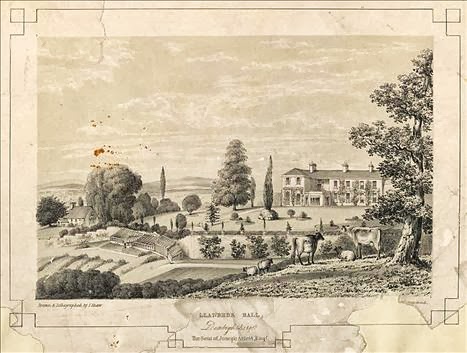Pont Hawkin and the Old Gaol c 1904
Ruthin Gaol c 2013
The first County Gaol and Courthouse in Ruthin was built in 1404, belonging to The Lord of Ruthin, not long after the rebellion of Owain Glyndwr which caused much destruction in the town.
The following account of
the courthouse was written in 1829 for the Welsh Literary Society of Ruthin.
THE OLD COURT HOUSE
A large block of 'black and
white' building situated in St. Peter's Square, formerly called Market
Place; now in the several occupations of Mr. J. E Jones,
Ironmonger; Mr. J. Royles, Bootmaker; and Mr. T. Evans, Grocer.
It was
built as a Court House and County Gaol in the year 1401, immediately after the
town was burnt down in September of the previous year: ˜During a fair
holden at Ruthin in the year 1400 Owen Glyndwr entered it with a small army,
assailed the fortress without success and after pillaging the inhabitants, and
burning the town retreated to the mountains. '
' On this site on 18th September 1400, the first flame in Owain Glyn Dwr's campaign was lit. The original building was burned and many Ruthin residents joined Prince Owain in the battle for the freedom of our nation.'
2008
Continued from the Welsh Literary Society of Ruthin:
'It is
evident from the present state of the building that it was built according to
the custom of those days, of the very best materials. We find it recorded in
history that many have been executed in this Gaol, the last execution being
that of Thomas Wright, a Schoolmaster of Wrexham, for being
concerned in a plot to overthrow the Protestant Religion, at the
commencement of Queen Elizabeth’s reign, he being a Papist at
heart.
The Old Courthouse
The building, from the end of the nineteenth century,
was owned by the Aldrich family. This they divided into shop units. At one
stage one of the units became a bank branch, the predecessor of the NatWest
bank.
The Old Court House
today
*2012 .This half-
timbered building in St. Peter’s Square was restored in 1926 and now houses the
National Westminster Bank. Part of the gallows ( gibbet ) can still be
seen projecting from the eaves to the right of the picture. Most
executions took place in Ruthin and the last one is believed to have been that
of a Franciscan Friar, Father Charles Mahoney on 12 August 1679.
The Welsh Catholic martyr, Richard Gwyn, after spending the last four years of
his life there, however, was executed at Wrexham in 1584.
THE OLD
GAOL, originated
as the first county House of Correction at Ruthin, was built in 1654.
Until the
sixteenth century, gaols were regarded mainly as a means of holding prisoners
awaiting trial; the actual punishment inflicted varied from fines, through a
spell in the stocks, to branding and execution. Towards the end of the
sixteenth century prisons had come to be used as a means of punishment - for
debt, non-payment of fines, minor misdemeanours and especially vagrancy.
Offenders and unconvicted persons, males and female, were usually crowded
together in conditions which bred disease and immorality.
Harry
Davies of Ruthin was appointed the first Master in 1655. The distinction
between gaols and houses of correction was never clearly defined in effect;
therefore, the Ruthin House of Correction came to be used more and more as a
place of detention with deteriorating living conditions.
In 1699 the authorities were said
to be building another prison on an adjoining site where an ancient house
called Porth y Dwr (Watergate) was the gate in the town's walls at the river
Clwyd.
In 1774, as a result of the
efforts of the prison reformers such as John Howard, two Acts of Parliament
were passed; to improve hygiene and medical care; to abolish payment by
prisoners upon discharge.
This same year the Denbighshire
justices decided to build an entirely new prison on the site of the House of
Correction, and in 1775 more cells and a chapel were added to the plans.
Over the front door on Clwyd
Street was the inscription:
THE
MAGISTRATES, SENSIBLE OF THE MISERABLE STATE OF THE ANCIENT PRISON, IN
COMPASSION TO THE UNFORTUNATE, CAUSED THIS BUILDING TO BE ERECTED IN THE YEAR
MDCCLXXV Jos. Turner Architect
CLWYD
STREET c 1910. ......... The gaol was formerly housed in the building on the
left (built in 1775 by Joseph Turner ), and after a separate cell block was
built in 1866, , the original building became the residence of the governor and
the gaol staff. Bars visible on the windows were removed after the gaol was
closed in 1916. The police station was housed in the gaol until the present
station was opened in Record Street in 1891. In 1824 a hangman, Sam Burrows,
was staying at the Red Lion inn , opposite the gaol. the night before the
execution of John Connor, a highway robber .
Three Kids Gripped By Evil By Polly Mullaney
Amazon Kindle, Amazon paperback






















